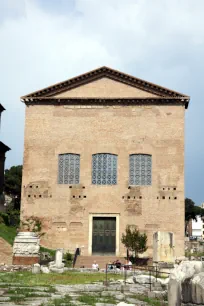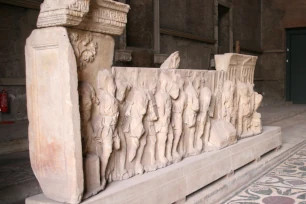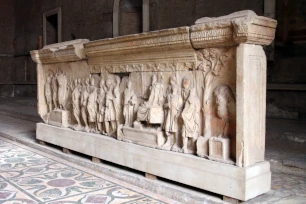One of the best preserved buildings at the Forum Romanum is the Curia, a rather modest looking brick building. Here assembled the Senate, the highest political institution of Ancient Rome.
History


The first Curia, the Curia Hostilius, was built in the seventh century BC, during the reign of Tullius Hostilius, the third king of Rome. It was situated just north of its current location, at the edge of the Roman Forum.
Throughout its history, the Curia burned down several times and was rebuilt each time. It was first rebuilt by Lucius Cornelius Sulla. After it burned down again in 57 BC, Julius Caesar ordered the construction of a new Curia and had it moved to its present site. This new building, known as the Curia Julia, was inaugurated in 29 BC by Emperor Augustus.
The structure we see today is a reconstruction of around 303 AD, during the reign of Diocletian. The Curia became a church – the Sant’Adriano church – as early as in 630, which explains why it has been so well-preserved. The building was restored in the 1930s, when all modifications from after the era of Diocletian were removed.
The Building
The rather plain structure must have looked pretty modest compared to the palatial marble temples and basilicas that stood nearby. Still, it didn’t look quite as basic as it does today. The brick walls were originally clad on the exterior with stone tiles. You can still see a small section of the original cladding right below the cornice.
The huge bronze doors are not original; these were removed in 1660 and replaced by reproductions. Francesco Borromini installed the ancient doors in the narthex of the Basilica of St. John Lateran.


Interior

Much of the interior however is still authentic and dates from the antiquity. It is surprisingly spacious, measuring twenty-seven by eighteen meters (approx. 90 x 60 ft). Some three hundred senators were able to assemble here. The floor is still intact, and is a fine example of a Roman tiled floor with geometric patterns created from different sorts of marble. The walls were also clad in marble; a small part of the off-white marble is visible at the back of the speaker’s platform. The ceiling is a recent reconstruction, in Rome’s glory days it was completely gilded.
Near the left and right wall are the Plutei Traiani (Plutei of Trajan) – travertine reliefs that depict Emperor Trajan helping Roman citizens. On the left, he is shown burning registrations of unpaid taxes; thereby waiving citizens of their tax debt. The other relief symbolizes the introduction of agricultural loans. The reliefs probably adorned the sides of the Rostra, a large speaker’s platform located nearby. The reliefs are also significant because they show us, in the background, what the Roman Forum looked like in the early second century AD.
- Next: Aventine Hill
- More Rome Ancient Sights
- More Sights & Attractions in Rome

